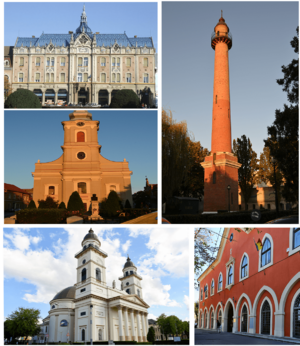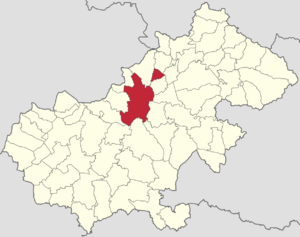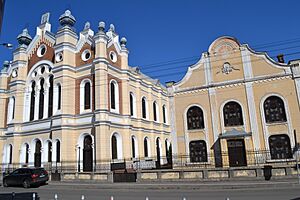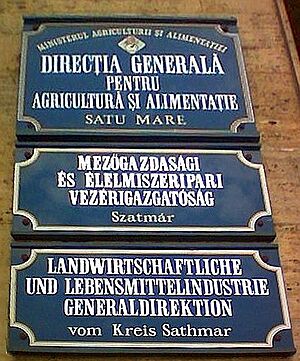Satu Mare facts for kids
Quick facts for kids
Satu Mare
Szatmárnémeti
|
|
|---|---|

Left to right: Dacia Hotel, Firemen's Tower, Vécsey Palace (art museum), Roman Catholic Cathedral, Chain Church
|
|

Location in Satu Mare County
|
|
| Country | |
| County | Satu Mare |
| Status | County seat |
| Founded | 972 (first official record as Villa Zotmar) |
| Component villages | Sătmărel |
| Area | |
| • Total | 150.3 km2 (58.0 sq mi) |
| Population
(2021-12-01)
|
|
| • Total | 91,520 |
| • Density | 669/km2 (1,730/sq mi) |
| Demonym(s) | sătmărean, sătmăreancă (ro), "szatmári","szatmárnémeti" (hu) |
| Time zone | UTC+2 (EET) |
| • Summer (DST) | UTC+3 (EEST) |
| Postal Code |
44xyz
|
| Area code(s) | +40 x61 |
| Car Plates | SM |
| Climate | Cfb |
Satu Mare is a city in Romania with about 91,520 people (as of 2021). It is the main city of Satu Mare County and a busy center for learning, culture, industry, and business. The city is located in the Maramureș region, which is part of Transylvania. Satu Mare has a long history, first being mentioned way back in the Middle Ages around the year 972.
Contents
Geography and Location
Satu Mare is in northwest Romania, right on the Someș River. It's only about 13 kilometers (8 miles) from the border with Hungary and 27 kilometers (17 miles) from the border with Ukraine. The city sits on a flat area next to the Someș River, about 126 meters (413 feet) above sea level. The city covers an area of about 150.3 square kilometers (58 square miles).
Land and Rivers
The land around Satu Mare was formed a very long time ago, from layers of sand, soil, and gravel. This makes the soil good for growing crops like cereals, vegetables, and fruits. The Someș River is very important to the city. It helped people settle here and allowed for trade with other regions. The river also supported activities like milling and fishing.
Over time, the Someș River had many bends, called meanders. To help prevent floods and make the river flow better, people worked to straighten parts of it. They also built walls, called embankments, along the riverbanks. These walls protect the city and nearby farmlands from flooding, especially during heavy rains.
Plants and Animals
The plants around Satu Mare are typical for a river meadow. You can find trees like willow, poplar, maple, and hazelnut. The grassy areas have common meadow plants.
The city's biggest park, the Garden of Rome, has some special trees that are not usually found in the area. These include the pagoda tree and Pterocarya, both from Asia, and Paulownia tomentosa from China.
Animals in the area include small rodents like hamsters and ground squirrels. You might also see reptiles, like the common European viper in the Noroieni forest. Many types of birds, such as ducks, geese, and egrets, visit the area.
Climate and Weather
Satu Mare has a continental climate. This means it has hot, dry summers and cold winters. Winters can be quite cold, with temperatures sometimes dropping to -17°C (1°F). The average temperature for the whole year is about 9.6°C (49.3°F). Spring is around 10.2°C (50.4°F), summer is 19.6°C (67.3°F), autumn is 10.8°C (51.4°F), and winter is 1.7°C (35.1°F). The air is usually quite humid. Winds mostly come from the northwest, bringing rain in spring and summer.
| Climate data for Satu Mare | |||||||||||||
|---|---|---|---|---|---|---|---|---|---|---|---|---|---|
| Month | Jan | Feb | Mar | Apr | May | Jun | Jul | Aug | Sep | Oct | Nov | Dec | Year |
| Mean daily maximum °C (°F) | 1 (34) |
3 (37) |
10 (50) |
15 (59) |
20 (68) |
22 (72) |
25 (77) |
25 (77) |
21 (70) |
15 (59) |
7 (45) |
2 (36) |
13 (55) |
| Mean daily minimum °C (°F) | −5 (23) |
−3 (27) |
1 (34) |
5 (41) |
9 (48) |
12 (54) |
13 (55) |
13 (55) |
10 (50) |
5 (41) |
0 (32) |
−2 (28) |
5 (41) |
| Average precipitation cm (inches) | 2 (0.8) |
2 (0.8) |
2 (0.8) |
4 (1.6) |
7 (2.8) |
8 (3.1) |
8 (3.1) |
7 (2.8) |
4 (1.6) |
4 (1.6) |
3 (1.2) |
2 (0.8) |
59 (23) |
| Source: weatherbase.com | |||||||||||||
City Name and Its Meaning
The Hungarian name for the city, Szatmár, likely comes from a person's name, Zotmar. An old book from the 1200s, called Gesta Hungarorum, mentions a fort called "Zotmar's fort" where Satu Mare is today. The name Satu Mare means "great village" in Romanian. It was first used in the 1800s. An older Romanian name, Sătmar, was officially changed to the current one in 1925.
A Brief History of Satu Mare
Archaeological finds show that people lived in this area since the Stone Age and Bronze Age. Even after the Romans conquered the land around 100 AD, local people called Dacians stayed here.
The city was first mentioned as "Zotmar's fort" in the 10th century. When Stephen I of Hungary founded the Kingdom of Hungary around the year 1000, German settlers came to live near the fort. Later, more German settlers joined them.
Satu Mare became a "royal free city" in the 1200s, which meant it had special rights and freedoms. The city changed hands many times. In 1526, the Báthory family took control and changed the Someș River's path to protect the fort, making it an island. The fort was later attacked and rebuilt several times.
In the Middle Ages, Satu Mare and a nearby settlement called Mintiu were separate. They joined together in 1715 and were called "Szatmár-Németi". In 1721, Emperor Charles VI officially recognized this union and gave Satu Mare its royal free city status. An important peace treaty, the Treaty of Szatmár, which ended a war for independence, was signed here in 1711.
The city grew because it was important for transporting and trading salt from nearby mines. In the 18th century, Satu Mare started to develop rapidly. Many old buildings from this time, like the old city hall and churches, are still standing. The first factories opened in the 1800s, including a steam mill and a brick factory. Satu Mare also became an important railway hub, connecting to other major cities.
In the late 1800s and early 1900s, the city's economy boomed. Large companies, banks, and shops grew. The city invested in better transportation, schools, hospitals, and parks.
After Austria-Hungary broke apart, Romanian troops took control of Satu Mare in 1919. The Treaty of Trianon officially made Satu Mare part of Romania. In 1940, it briefly became part of Hungary again, but in 1944, it was captured by the Soviet army and returned to Romania after 1945.
The Jewish Community
Jewish people have lived in this region since the late 1500s. In Satu Mare, they were allowed to settle in the early 1700s. They worked in farming, trade, and industry. In 1715, they were asked to leave but began to return in the 1820s. The first Jewish community was officially formed in 1849, and a synagogue was built in 1857.
In the 1920s, Satu Mare had several large synagogues and a big school for Jewish studies with 400 students. In 1930, there were five large synagogues and about 20 smaller prayer houses.
| Jewish population of Satu Mare | |||||||||||||
| Year | Jewish population (% of total population) |
||||||||||||
|---|---|---|---|---|---|---|---|---|---|---|---|---|---|
| 1734 | 11 | ||||||||||||
| 1746 | 19 | ||||||||||||
| 1850 | 78 | ||||||||||||
| 1870 | 1,357 (7.4%) | ||||||||||||
| 1890 | 3,427 (16.5%) | ||||||||||||
| 1910 | 7,194 (20.6%) | ||||||||||||
| 1930 | 11,533 (21%) | ||||||||||||
| 1941 | 12,960 (24.9%) | ||||||||||||
| 1944 | ~20,000 | ||||||||||||
| 1947 | 5,000 to 7,500 | ||||||||||||
| 1970 | 500 | ||||||||||||
| 2011 | 34 | ||||||||||||
When Satu Mare became part of Hungary again in 1940, the rights of Jewish people were limited. In 1944, the Jewish population was forced into a special area called the Satu Mare ghetto. Many were sent to forced labor, and others were sent to camps where they were tragically killed. Thousands of Jewish people from Satu Mare and nearby areas were deported.
After the war, only a small number of survivors returned to Satu Mare. Many later moved to Israel. By 2011, only 34 Jewish people remained in the city. In 2004, a memorial was built in the Decebal Street Synagogue courtyard to remember those who were lost. Two Jewish cemeteries also remain.
Population and People
According to the 2021 census, Satu Mare has a population of 91,520 people. This makes it the 20th largest city in Romania.
Ethnic composition of Satu Mare (2021) Romanians (61.87%) Hungarians (36.29%) Germans (Sathmar Swabians) (1.06%) Others (0.78%)
Religious composition of Satu Mare (2021) Romanian Orthodox (50.14%) Roman Catholics (19.12%) Reformed (19.07%) Greek Catholics (6.60%) Pentecostals (1.60%) Others (2.48%) Irreligious,atheist and agnostic (1.00%)
| Year | Population | Romanians | Hungarians | ||||||||||
|---|---|---|---|---|---|---|---|---|---|---|---|---|---|
| 1880 | 7.9% | 83.1% | |||||||||||
| 1890 | 8.1% | 89.9% | |||||||||||
| 1900 | 7.8% | 89.01% | |||||||||||
| 1910 | 6.3% | 91.4% | |||||||||||
| 1920 | 15.2% | 63.6% | |||||||||||
| 1930 | 28.9% | 57.1% | |||||||||||
| 1941 | 6.6% | 90.2% | |||||||||||
| 1956 | 36.5% | 58.2% | |||||||||||
| 1966 | 44.2% | 54.9% | |||||||||||
| 1977 | 51.04% | 47.2% | |||||||||||
| 1992 | 55.8% | 43.2% | |||||||||||
| 2002 | 57.9% | 39.3% | |||||||||||
| 2011 | 58.9% | 37.6% | |||||||||||
| 2021 | 61.9% | 36.3% | |||||||||||
|
Source (where not otherwise specified): |
|||||||||||||
Getting Around Satu Mare
Satu Mare has a good transportation system, connecting it to other cities in Romania and Europe by road, rail, and air. It's an important hub because it's close to the borders with Hungary and Ukraine.
Road Travel
The city is connected to major Romanian cities by important roads like European route E81, European route E671, and European route E58. In 2008, there were 82,000 cars registered in Satu Mare. The city has about 400 streets, totaling 178 kilometers (111 miles) in length.
Train Travel
The main train station is about 2 kilometers (1.2 miles) north of the city center. It's on important train lines that connect to major Romanian cities and even to Budapest in Hungary. There's also a smaller train station called the Saw Station.
Public Transportation
The main way to get around Satu Mare using public transport is by bus. There are 23 bus lines that cover the city and its nearby areas, totaling 190.1 kilometers (118 miles). The main company running these buses is Transurban S.A. You can also find many taxi companies in the city. Satu Mare used to have trolleybuses, but they stopped running in 2005.
Airport Access
The city has its own airport, Satu Mare International Airport, located 13 kilometers (8 miles) south of the city. It has a long concrete runway. Airlines like TAROM and Wizz Air offer regular flights to cities like Bucharest and London, and seasonal flights to Antalya.
Sports and Fun Activities
Football (soccer) is very popular in Satu Mare. The city has two main football clubs, Olimpia and Someșul Oar, and two football stadiums.
Other popular sports and activities include fencing, handball, bowling, women's basketball, karate, and chess.
The local women's basketball team, CSM Satu Mare, is one of the best in Romania. They play their games in the LPS Arena, which can hold 400 people.
Fencing History
Satu Mare has a long and proud history in fencing, going back to 1885. Many world and Olympic champions in fencing have come from this city. Famous names like Ecaterina Stahl and Alexandru Csipler are part of Romanian fencing history. The city's fencing school has won many important competitions. In 1973, Satu Mare was the first city in Romania to use a special electronic device to signal hits in fencing, which was a big step forward for the sport.
Economy and Business
Satu Mare's location near the borders of Hungary and Ukraine makes it a great place for businesses and factories. Many international companies have set up production facilities here.
Some big companies in Satu Mare include:
- Dräxlmaier Group: A German company that makes parts for electric car engines. They are the largest private employer in Satu Mare, with about 3,600 employees.
- Electrolux: A Swedish company that owns a kitchen stove factory. They make many of the Zanussi brand kitchen stoves sold in Europe.
- Voestalpine: An Austrian company that produces steel tubes.
Satu Mare also has a well-developed shopping scene. Many international supermarkets and hypermarkets like Carrefour, Auchan, and Kaufland are in the city. There are also shopping malls like Shopping City Satu Mare and Grand Mall.
The city also has an industrial park called Satu Mare Industrial Park, which is a large area for businesses and factories.
Learning and Education
Satu Mare is a center for learning, with several universities and many high schools.
Universities in Satu Mare
The city is home to the Commercial Academy of Satu Mare and has branches of other important Romanian universities, including:
- Babeș-Bolyai University
- Spiru Haret University
- Technical University of Cluj-Napoca
- University of Oradea
- Vasile Goldiș West University of Arad
High Schools in Satu Mare
Satu Mare has 16 high schools, with four of them being national colleges:
- Doamna Stanca National College
- Ioan Slavici National College
- Kölcsey Ferenc National College
- Mihai Eminescu National College
Middle Schools in Satu Mare
The city has 16 middle schools (gymnasiums). Some of the most well-known include:
- The Grigore Moisil Gymnasium, named after the famous mathematician Grigore Moisil.
- The Ion Creangă Gymnasium, named after the writer Ion Creangă.
- The Lucian Blaga Gymnasium, named after the philosopher and writer Lucian Blaga.
Culture and Arts
Satu Mare has a county museum, an art museum, and a theater called the North Theatre. The theater was built in 1889 and has both Hungarian and Romanian sections. You can also enjoy concerts by the “Dinu Lipatti Philharmonic” orchestra. The county library has a huge collection of books, including many rare and special ones.
Places to Visit
If you visit Satu Mare, here are some interesting places to see:
- Administrative Palace: One of the tallest buildings in Romania, standing 97 meters (318 feet) tall.
- Capitoline Wolf statue: A famous statue.
- Chain Church: A historic church.
- Dacia Hotel: A beautiful old hotel.
- Decebal Street Synagogue: A historic synagogue.
- Firemen's Tower: A 47-meter (154-foot) tall tower with great views.
- Roman Catholic Cathedral: A large and impressive church.
Media and News
Satu Mare has several local newspapers, TV stations, and radio stations that keep people informed.
Newspapers
- Informația Zilei
- Gazeta de Nord-Vest
- Cronica Sătmăreană
- Friss Újság (in Hungarian)
- Szatmári Magyar Hírlap (in Hungarian)
TV Stations
- TV1 Satu Mare
- Nord Vest TV
- Pro TV Satu Mare
- Informația TV
Radio Stations
- Radio City Satu Mare
- Radio Unu
- Radio Transilvania
- Radio ZU
- Kiss FM Satu Mare
Online News
- Satu Mare Online
- Sătmăreanul
International Connections
Satu Mare has "twin town" or "sister city" relationships with several cities around the world. This means they share cultural and educational exchanges.
Twin Towns and Sister Cities
Satu Mare is connected with:
 Zutphen, Netherlands (since 1970)
Zutphen, Netherlands (since 1970) Wolfenbüttel, Germany (since 1974)
Wolfenbüttel, Germany (since 1974) Nyíregyháza, Hungary (since 2000)
Nyíregyháza, Hungary (since 2000) Berehove, Ukraine (since 2007)
Berehove, Ukraine (since 2007) Rzeszów, Poland (since 2007)
Rzeszów, Poland (since 2007)
Images for kids
See also
 In Spanish: Satu Mare para niños
In Spanish: Satu Mare para niños














